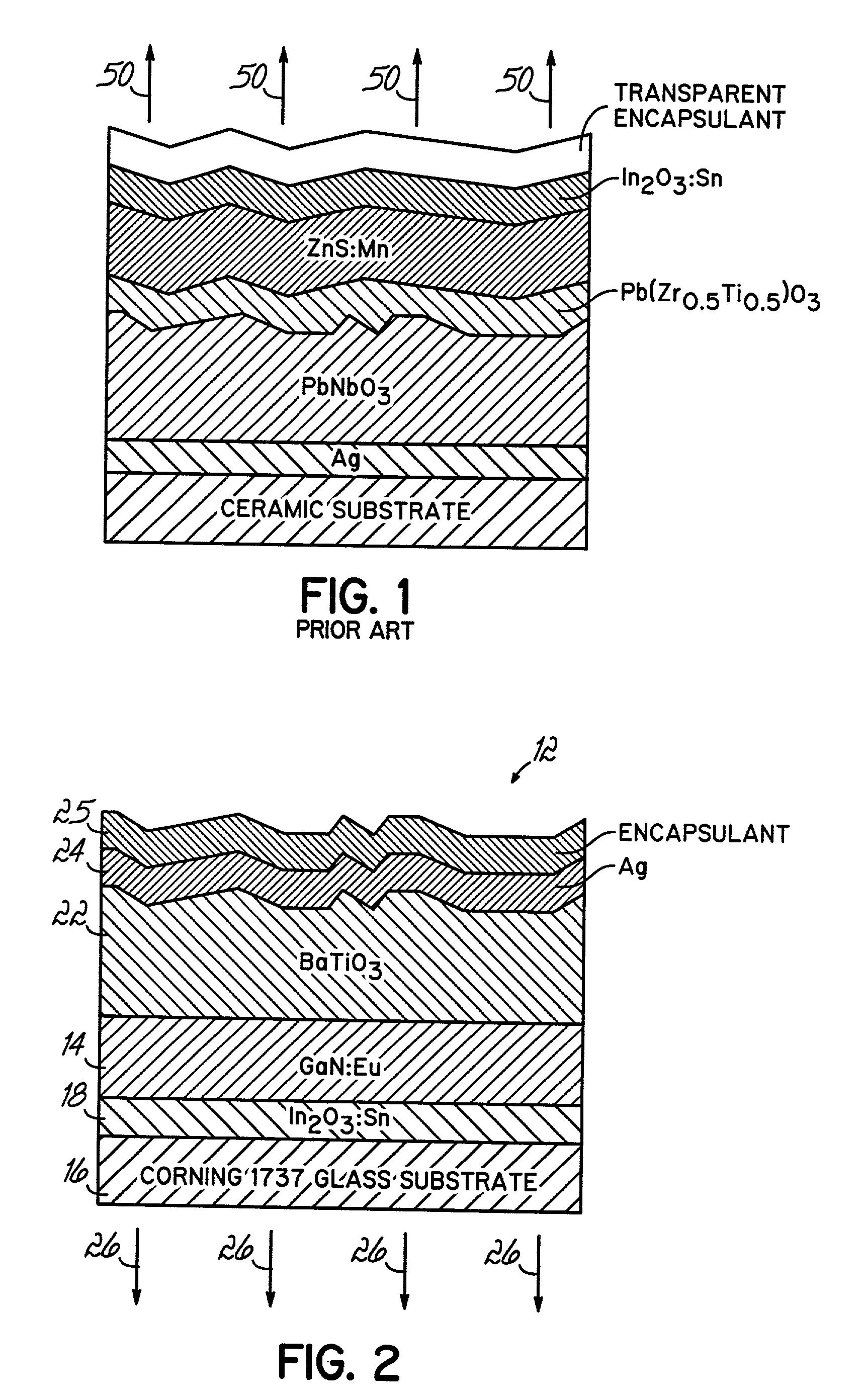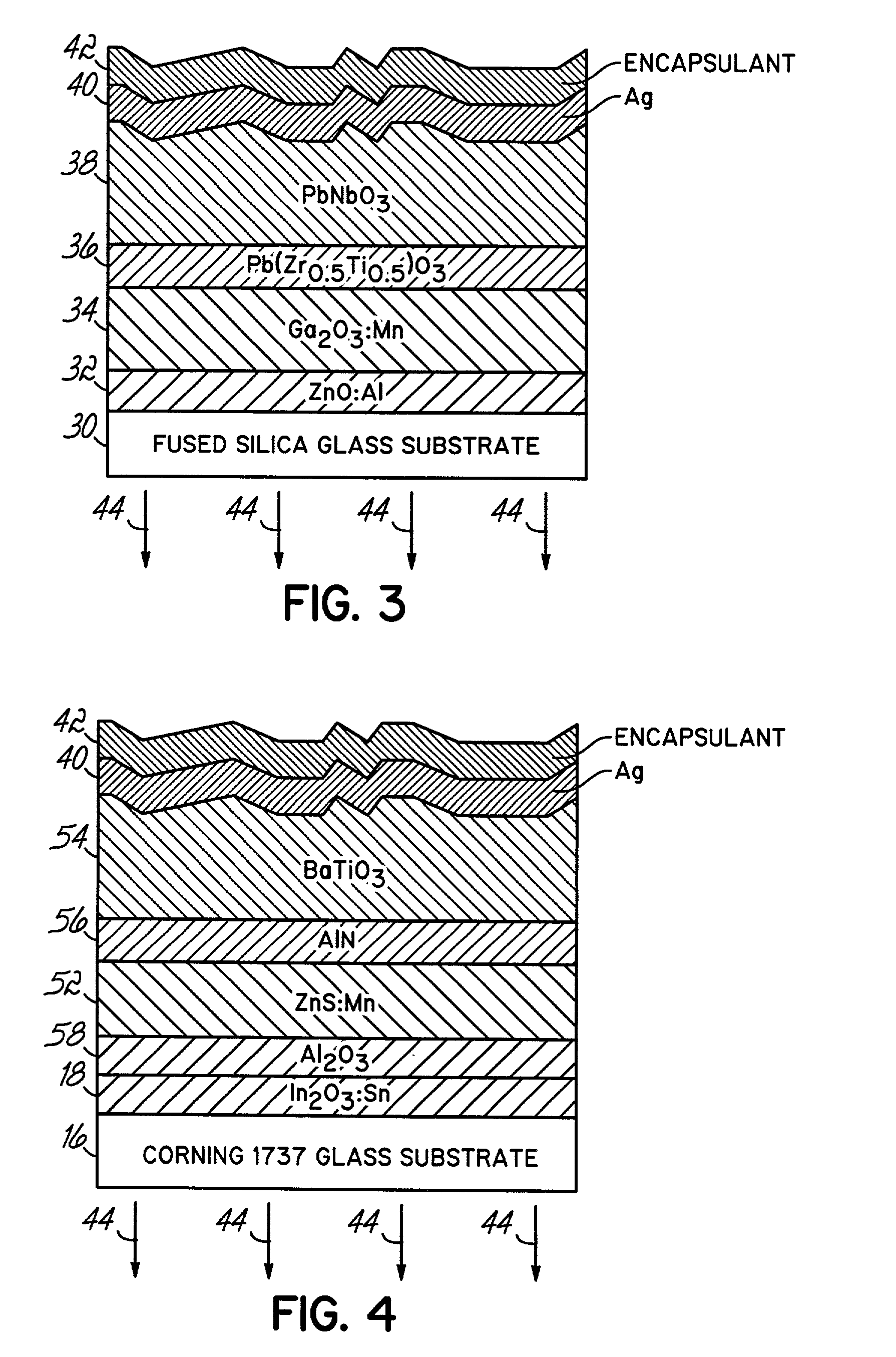Electroluminescent display formed on glass with a thick film dielectric layer
a technology of dielectric layer and glass, which is applied in the direction of discharge tube luminescnet screen, discharge tube/lamp details, electric discharge lamps, etc., can solve the problems of premature electrical breakdown limited thickness of the dielectric layer, and different constraints on the deposition equipment and surrounding cleanliness
- Summary
- Abstract
- Description
- Claims
- Application Information
AI Technical Summary
Benefits of technology
Problems solved by technology
Method used
Image
Examples
example 1
[0028] Dupont 9970 Ag:Pt paste was screen printed onto alumina substrates, dried, and fired at 850.degree. C. for ten minutes. One or two layers of Dupont 5540 dielectric paste were screen printed, dried and sintered at 850.degree. C. for ten minutes. The 5540 paste contains barium titanate along with glass or fluxing agents that facilitate lower temperature (<900.degree. C.) sintering of the dielectric. A scanning electron microscope photograph showed that the thick-film dielectric layer has a surface roughness of .about.1 micron and is granular with high porosity. The resulting dielectric layer thickness was 20-40 microns with a permittivity of .epsilon..about.6000. A GaN:Er phosphor film of .about.1 micron thickness was then deposited by solid-source molecular beam epitaxy onto the dielectric / metal / ceramic substrates. .about.300 nm thick indium-tin-oxide transparent electrodes were then sputtered through a stencil mask onto the GaN:Er phosphor film. The resulting structure was bi...
example 2
[0029] .about.300 nm indium-tin-oxide films were deposited on Corning 1737 glass substrate which has a thermal strain point of 666.degree. C., sufficiently above the .about.600.degree. C. substrate temperature used during gallium nitride phosphor deposition. Corning 1737 is a widely utilized display glass due to its compatibility with low temperature (500-600.degree. C.) poly-Si processing used for active-matrix liquid crystal displays. Approximately 1 micron thick erbium doped gallium nitride phosphor film was deposited by solid-source molecular beam epitaxy onto the indium-tin-oxide coated 1737 glass substrates. Following phosphor deposition, 1 layer of Dupont 5540 dielectric paste was screen printed, dried, densified for 10 minutes at .about.600.degree. C., and sintered at .about.800.degree. C. for 4 minutes. The resulting dielectric layer had a thickness of .about.20 microns, breakdown strength >200 V, and permittivity of .epsilon..about.500-1000. Rear electrodes were formed by ...
example 3
[0031] A device similar to that of Example 2 was formed with the following changes to fabrication of the thick-film dielectric layer. Following the phosphor deposition, 1 layer of Dupont 5540 dielectric paste was screen printed, dried, densified for 1 minutes at .about.600.degree. C. A second layer of Dupont 5540 dielectric paste was then screen printed, dried, and densified for 10 minutes at .about.600.degree. C. This stock of two dielectric layers was then sintered at .about.800.degree. C. for 4 minutes. The resulting dielectric layer had a thickness of .about.40 microns, breakdown strength >300 V, and permittivity of .epsilon..about.500-1000. The device exhibited similar luminance characteristics to that of Example 2 but showed improved reliability at high voltages (>300 V breakdown).
PUM
 Login to View More
Login to View More Abstract
Description
Claims
Application Information
 Login to View More
Login to View More - R&D
- Intellectual Property
- Life Sciences
- Materials
- Tech Scout
- Unparalleled Data Quality
- Higher Quality Content
- 60% Fewer Hallucinations
Browse by: Latest US Patents, China's latest patents, Technical Efficacy Thesaurus, Application Domain, Technology Topic, Popular Technical Reports.
© 2025 PatSnap. All rights reserved.Legal|Privacy policy|Modern Slavery Act Transparency Statement|Sitemap|About US| Contact US: help@patsnap.com



